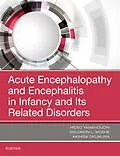Stay current with recent progress in the field of acute encephalopathy and encephalitis in infants with this practical resource by Drs. Hideo Yamanouchi, Solomon L. Moshé, and Akihisa Okumura. This practical resource covers key information relevant to physicians, surgeons, and nurses who often must take prompt action in the everyday clinical care of patients with these disorders.
- Features a wealth of information for all health care professionals who encounter these complex conditions.
- Covers diagnostic strategy, subtypes of acute encephalopathy, and management of acute encephalopathy and encephalitis.
- Consolidates today's available information and guidance on acute encephalopathy and encephalitis in infancy, in addition to related disorders, into one convenient resource.
Autorentext
Dr. Moshé is the is the Charles Frost Chair in Neurosurgery and Neurology and Professor of Neurology, Neuroscience, and Pediatrics at Albert Einstein College of Medicine. He is the Director of Child Neurology and Clinical Neurophysiology Dr. He has been President of the International League Against Epilepsy, American Epilepsy Society and American Clinical Neurophysiology Society (1996-1997). He is the recipient of several honors and awards, including Teacher-Investigator Development Award; Jacob Javits Neuroscience Investigator Award from NIH; Michael Prize for Achievement in Epilepsy Research; The American Epilepsy Society Research Award; Ambassador for Epilepsy Award from the International League Against Epilepsy; the Gloor Award from the American Clinical Neurophysiology Society; J.E. Purkyne Honorary Medal in Biomedical Research by the Czech Academy of Sciences; the 2008 Mentor of the Year Award from Albert Einstein College of Medicine; The 2010 Global and Awareness Award from Citizens United for Research in Epilepsy; the First Saul R. Korey Award in Translational Science and Medicine, Albert Einstein College of Medicine in 2012; elected Foreign Member of the Russian Academy of Sciences and Fellow of the American Epilepsy Society 2016. Since 1979, his research has focused on understanding the mechanisms underlying age-related differences in epilepsy in humans and in animal models.
Inhalt
SECTION I INTRODUCTION
1 Overview and Definitions 2 Classification and Epidemiology of Acute Encephalopathy
SECTION II PATHOPHYSIOLOGY
3 Translational Studies of Infantile Epileptic Encephalopathies 4 Ictogenic and Epileptogenic Mechanisms of Neuroinflammation: Insights From Animal Models 5 Neuroinflammation in the Pathogenesis of Early Life Epileptic Encephalopathies 6 Genetic Background of Encephalopathy
SECTION III DIAGNOSTIC STRATEGY
7 Neuroimaging on Pediatric Encephalopathy in Japan 8 Electroencephalography in Children With Acute Encephalitis/Encephalopathy 9 Electroencephalographic Approach for Early Diagnosis of Acute Encephalopathy and Encephalitis 10 Biomarkers for the Diagnosis and Evaluation in Acute Encephalopathy 11 Differential Diagnosis
SECTION IV SUBTYPES OF ACUTE ENCEPHALOPATHY
12 Acute Necrotizing Encephalopathy 13 Acute Encephalopathy With Febrile Convulsive Status Epilepticus (AEFCSE) 14 Acute Mitochondrial Encephalopathy 15 Genetic-Metabolic Disorders Presenting as Acute, but Reversible, Severe Epilepsies 16 Acute Encephalopathy in Infants With Sulfite Oxidase Deficiency and Molybdenum Cofactor Deficiency
SECTION V SUBTYPES OF ACUTE ENCEPHALITIS
17 Autoimmune Encephalitis: Overview of Clinical Recognition, Autoantibody Diagnostic Markers, and Treatment of Autoimmune Encephalitis 18 Acute Disseminated Encephalomyelitis 19 Epidemiology of Acute Disseminated Encephalomyelitis 20 Autoimmune-Mediated Encephalitis With Antibodies to NMDA-Type GluRs: Early Clinical Diagnosis 21 Clinical Features of HHV-6B Encephalitis: Difference Between Primary Infection and Reactivation 22 Bacterial, Fungal, and Parasitic Encephalitis
SECTION VI ENCEPHALOPATHY / ENCEPHALITIS WITH REFRACTORY EPILEPTIC STATUS: RIMA NABBOUT
23 Febrile Infection-Related Epilepsy Syndrome 24 Acute Encephalitis With Refractory, Repetitive Partial Seizures 25 Children With Encephalitis/Encephalopathy-Related Status Epilepticus and Epilepsy-A Global View of Postencephalitic Epilepsy
SECTION VII MANAGEMENT OF ACUTE ENCEPHALOPATHY AND ENCEPHALITIS
26 Intensive Care Management of Acute Encephalopathy and Encephalitis 27 Strategy for the Treatment of Intractable Epilepsy Secondary to Acute Encephalopathy and Encephalitis 28 The Pros and Cons of Therapeutic Hypothermia for Acute Encephalitis and Refractory Status Epilepticus 29 Therapeutic Hypothermia as Potential Intervention on Acute Encephalopathy 30 Neurosurgical Interventions for Encephalitis-Related Seizures and Epilepsy 31 Rehabilitation After Acute Encephalopathy in Childhood
